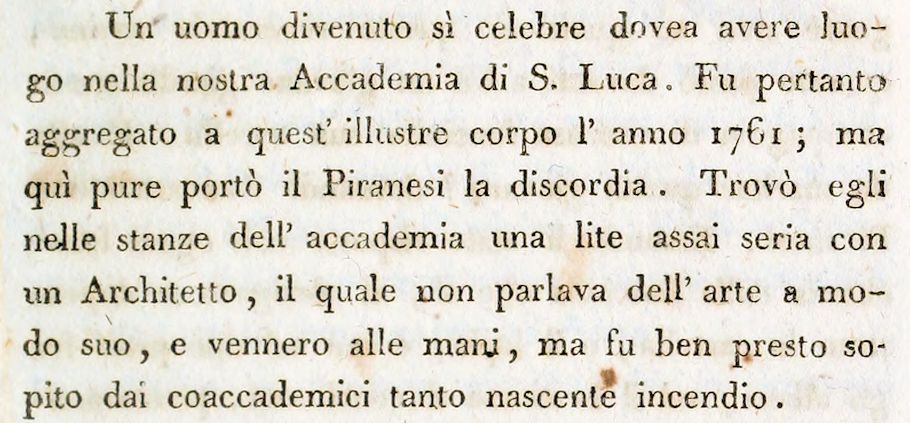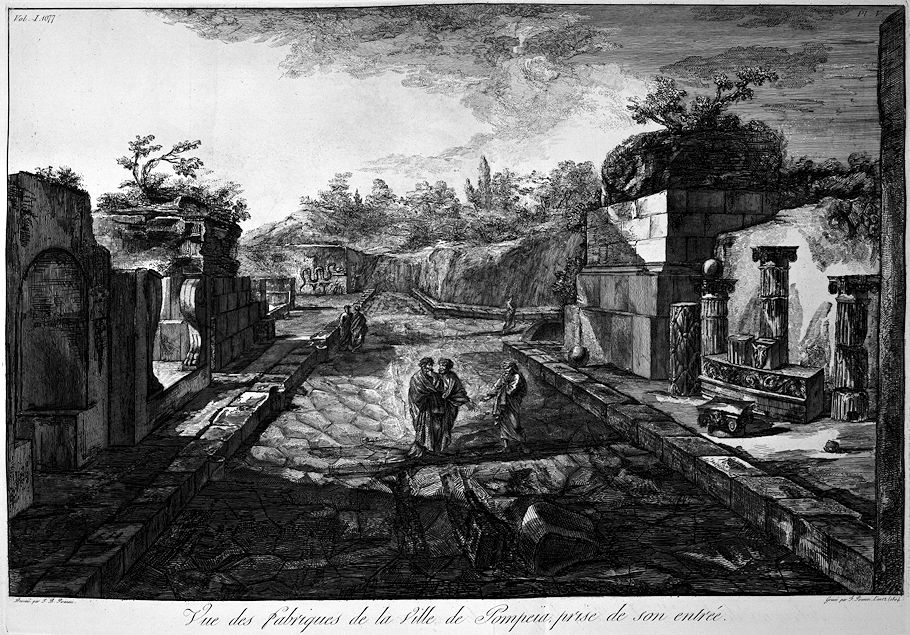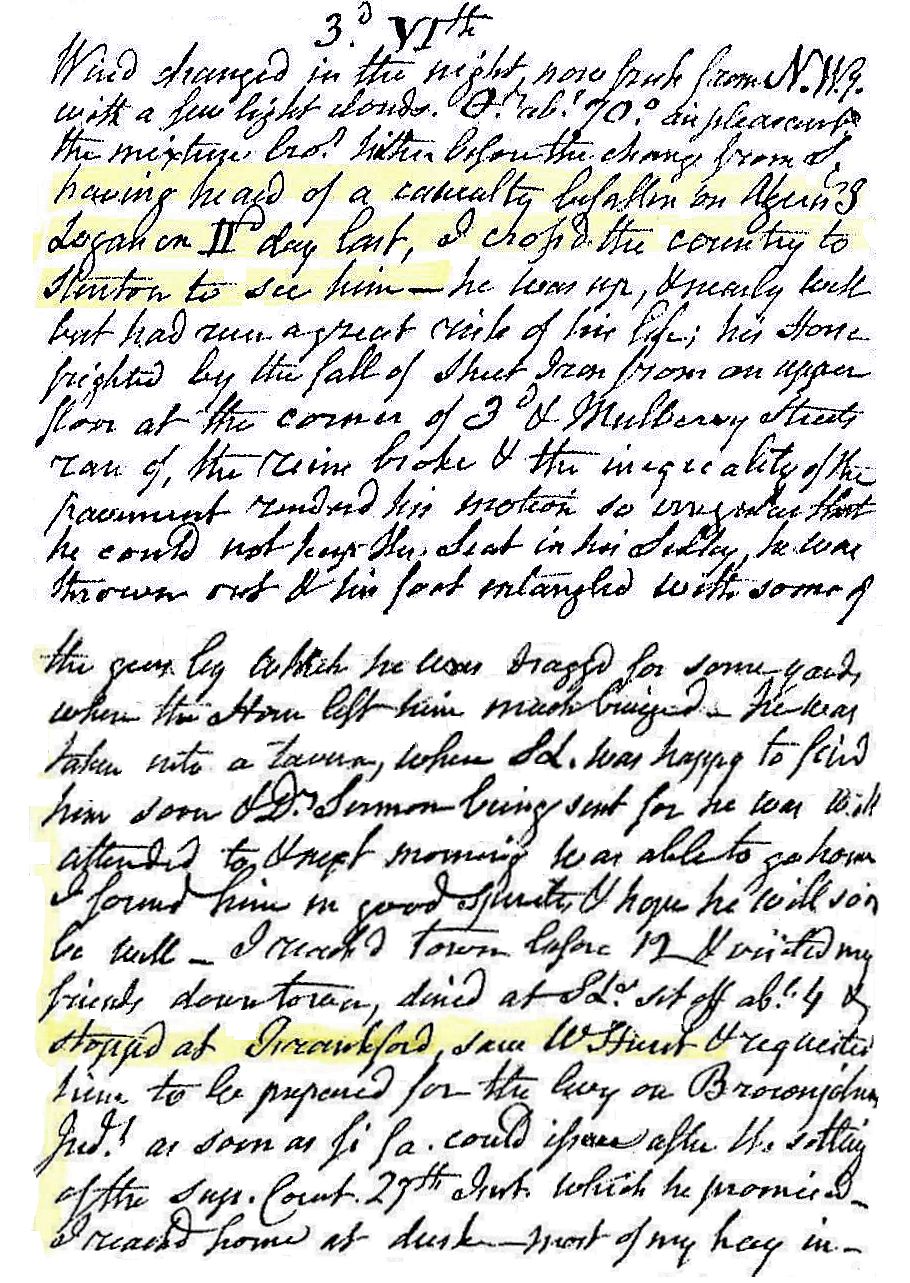3 July 1778 Friday
. . . . . .
Artifacts of the Bianconi vs Piranesi 'Circus of Caracalla' affair 1772-1789
8. A quotation from Bianconi's Elogio storico del cavaliere Giovanni Battista Piranesi, celebre antiquario ed incisore di Roma:

A man who became so famous had to take place in our Academy of S. Luca. It was therefore aggregated to this illustrious body in the year 1761; but here too Piranesi brought discord. In the rooms of the academy he found a very serious quarrel with an architect, who did not speak of art in his own way, and they came to blows, but the nascent fire was soon put to sleep by the co-academics.
"Perhaps the disillusionment with his compatriots stemmed from his dispute with the Accademia de S. Luca. He had been elected a member of the long-established but rather moribund institution in January 1761, on the same day as Gavin Hamilton, Thomas Jenkins and several members of the Rezzonico family. The arguments arose out of a discussion on the form of a memorial to Pio Balestra, an architect who had left his fortune to the academy to establish a prize fund. On 9 September 1772, ten years after the donor's death, the academy met to choose a design for a memorial to their benefactor in Pietro da Cortona's Baroque church of SS. Martina e Luca overlooking the Forum. Rejecting two schemes on the grounds of expence, the selected one by Tommaso Righi, the sculptor who had worked for Piranesi in S. Maria del Priorato; Raphael Mengs, the principal of the academy, was charged with drawing up a contract. A month later, [2 October], Piranesi caused an uproar in the assembly by rejecting to the design; the minutes of the meeting only state that there were 'disputes and altercations which caused disorders among the members'. Bianconi, however, relates the Piranesi actually came to blows with his opponents. The same day he wrote a long memorandum to Mengs setting out his views. Obviously he considered that Righi's design was too formal and unimaginative; he wanted to turn the church into a pantheon of the academy's most distinguished members and benefactors with monuments to suit the architecture, and, for a start, Balestra's memorial should be full of allegorical allusions like the vigorous Baroque figures by Le Gros on either side of the altar of St. Ignatius in the church of the Jesuits. Perhaps he was influenced by recollections of the allegorical statuary of his friend Corradini which he had seen as an impressionable youth. Certainly the sculptures in the Ges¨ must have seemed very dated half a century later both morally and artistically: Religion triumphs rather too robustly over Heresy as gleeful cherubs shred the works of Luther, and the Protestant fathers are tumbled hellwards by a then still confidently invincible Faith. At any rate, when Piranesi's letter was read to the assembly three weeks later, neo-classical restraint was the order of the day, his appeal to old fashioned luxuriance was voted out unanimously and Righi's conventional design of cherubs and artist's tools was duly executed. In disgust, Piranesi avoided the academy for the next six years although he did attend a meeting [11] October 1778, the month before he died. It was not a proper reconciliation; in contrast to the official mourning for Mengs in 1779, his death is passed over in silence in the academy's records."
Jonathan Scott, Piranesi (London: Academy Editions, 1975), pp. 245-6.
The 2 October 1772 event may well be what made it easy for Bianconi to disparage Piranesi's Circus of Caracalla work; Bianconi feeling sure those "that mattered most" would be on his side.
46 y.o. Francesco Piranesi 1804
Le AntichitÓ della Magna Grecia Parte I

View of the structures of the City of Pompeii, taken from its entrance.
Drawn by G.B. Piranesi
Engraved by F. Piranesi Year 12 (1804)
3 July 1812 Friday

Wind changed in the night, now fresh NWerly with a few light clouds. Temperature about 70░. Air pleasant, the mixture brought hither before the change from S. Having heard of a casualty befallen on Algernon Logan on Monday last, I crossed the country to Stenton to see him. He was up and nearly well, but had run a great circle[?] of his life; his horse frightened by the fall of sheet iron from an upper floor at the corner of 3rd and Mulberry Streets ran off, the reins broke, and the inequality[?] of the pavement rendered his motion so .........[?] that he could not keep his seat in his Sedley[?]. He was thrown out and his foot entangled with some of the .......[?] whence[?] he was dragged for some yards, where the horse left him much bruised[?]. He was taken into a tavern where SL was happy to find him soon and Dr. Sermon being sent for. He was well attended to and next morning was able to go home. I found him in good spirits and hope he will soon be well.
I reached town before 12 and visited my friends downtown. Dined at SL's. Set off about 4 and stopped at Frankford, saw W Hurst and requested[?] him to be prepared for the levy on Brownjohn judgement[?] as soon as fi fa could issue after the settling of the Superior[?] Court 27th Inst.[?], which he promised. I reached home at dusk. Must of my hay in.
3 July 2007
There goes that bilocation again.
"Did you notice how Chapter 3 of Against the Day is entitled "Bilocations"?
"Yes, I did."
"Don't you think it's strange that Pynchon should incorporate "bilocation" into a novel a couple years after you did?"
"Who knows? Maybe Pynchon read The Odds of Ottopia while it was simultaneously written and published online."
3 July 2022
Last Sunday I decided to find out whatever I could about Piranesi's activities in 1778. Scott deduces Piranesi, along with Francesco, Mori and Rosa, went to Naples and Paestum one last time late 1777 or spring 1778,16 yet Wilton-Ely finds the evidence to support exactly such a group journey meager.17 The date of such a nonetheless likely journey probably does not matter since the imprimatur for the Paestum series was received 15 September 177818, which means Piranesi's workshop was very busy with Paestum series work during the first eight months of 1778. As already mentioned, MacDonald and Pinto deduce the plan of Hadrian's Villa was being etched on copper plates also in 1778. Plus, "Piranesi and his thriving workshop had begun to issue plates of antiquities as a form of advertisement, Eventually some 110 of these were collected into two volumes published as Vasi, Candelabri, Cippi, Sarcofagi in 1778."19 "In May 1778 [Piranesi] sent a letter to a friend enclosing a sketch [dated 12 May 1778] of some idiosyncratic ideas for his own funeral monument,"20 and, after an absence of six years, Piranesi attended a meeting at the Accademis di S. Luca in October 1778.21 Piranesi's workshop in 1778 seems to have been busy enough, but there is also the suggestion that Piranesi was nevertheless beginning to think about how he would like to be memorialized.
15. Mario Bevilacqua, "Piranesi 1778. Ricerche interrotte, opere perdute" in V. Cazzato, S. Roberto, M. Bevilacqua (a cura di), Il teatro delle arti. Saggi in onore di Marcello Fagiolo per 50 anni di studi, II, Roma, Gangemi 2014, p. 797.
16. Jonathan Scott, Piranesi (London: Academy Editions, 1975), p. 254.
17. John Wilton-Ely, The Mind and Art of Giovanni Battista Piranesi (London: Thames and Hudson, 1978), p. 117.
18. Luigi Ficacci, Giovanni Battista Piranesi: The Complete Etchings (Cologne: Taschen, 2000), p. 664.
19. John Wilton-Ely, The Mind and Art of Giovanni Battista Piranesi (London: Thames and Hudson, 1978), p. 117.
20. Jonathan Scott, Piranesi (London: Academy Editions, 1975), pp. 251 and 318.
21. Ibid, p. 246.
3 July 2023 Monday
. . . . . .
|